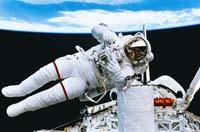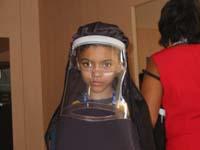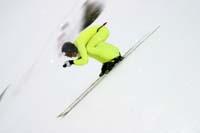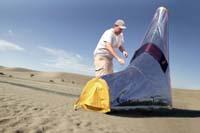Space technology, live

The sensors used to control the health status of astronauts are very useful in medicine. (Photo: NASA)
ESA, the European Space Agency, calls technology transfer to the transformation of space technology on land and has a specific program for the search and marketing of these applications. The members of ESA are convinced that the technology that develops for space can bring great benefits to everyday life in many areas: health, environment, engineering...
In fact, the space environment is really demanding and the technology that develops for its operation must be necessarily indifferent. Among other things, it must be light, resistant and durable, efficient, safe, compact, able to withstand very high and very low temperatures, resistant to radiation and corrosion. Of course, on Earth, in many ways and circumstances, the devices and apparatuses with these characteristics are highly appreciated.
In addition, technology transfer allows for a higher performance of the money spent on space research. And, in passing, it allows people from the street to see that the technology developed from a distance can also be close. In fact, an example of technology transfer can be seen where less is expected.
From the spacecraft to the hospital

Due to a genetic disease, some cannot withstand ultraviolet radiation. For them they have developed a special sponsor based on space technology. (Photo: ESA)
In medicine, for example, it is common to use technology developed for space. Astronauts are faced with special situations such as weightlessness, limited space to move, stress... To see how their bodies respond, they are placed numerous sensors that control breathing, heart beat, and other parameters. Many of them are used immediately in hospitals.
Another example is the systems of destruction of microorganisms. Astronauts cannot be in danger of getting sick, so it is essential to remove all the bacteria, viruses and fungi that can exist in the air of the spacecraft.
To do this, they use cameras that combine the powerful electric field with cold plasma in space ships, something already used in many European hospitals, especially to treat patients with a very affected immune system.
Although these applications are quite visible, there are more eye-catching ones. For example, few know that the origin of the universe, black holes, and devices that have been invented to observe certain phenomena that occur in space, are useful for detecting cancer or for following blood flow.
Star of the sport

The Rossignol group wants to reach the speed of 225 km/h with skis made with material of the Rosetta spacecraft. (Photo: ESA)
Or
A step beyond intuition, spatial research also affects sport. For example, an appliance used by astronauts for physical exercise is being adapted for it to be used at home. Yes, if you want to use astronauts to advertise the gymnastics apparatus of the house, you will have to show how they are without clothes, because if you do not notice anything or muscle.The spatial advances are not only reflected in the care of the body, but also in the sports material. In many sports, the material is very important and they always look for suitable materials. Rossignol, for example, manufactures skis and finds its last breakthrough in the Rosetta spacecraft. With the use of a local material, it has managed to reduce the vibration of the skis and with it they expect to reach a speed of 225 km/h on the ski. It's not a silly brand!
However, perhaps the greatest benefit of technological progress is for the disabled. More than one athlete with serious physical problems has managed to progress and improve his brands thanks to his prosthesis of space technology. Of course, in addition to the handicapped athletes, they also benefit the diminished physicists who do not practice sport.
For the environment
Spacecraft, like the international space station, are closed ecosystems. You have to adapt to the existing resources, since it is difficult to get more, so you have to reuse and recycle as much as possible. In addition, since the waste cannot be eliminated in any way, the engineers of the space are forced to devise systems that allow the minimization and maximum use of them.
Of course, the technology that is generated to achieve these objectives is increasingly necessary on Earth, since the Earth is also a closed ecosystem, although larger than a spacecraft. Water purification systems, methods of cultivation of plants from waste, efficient engines that use renewable energies… all are as useful as in space on Earth.
In short, it is clear that from space one looks as much as from Earth to heaven, and with the aim of applying technology.
In the desert as at home

Inflatable shop of the desert. (Photo: ESA)
A shop designed by ESA allows you to enjoy a cozy corner in the desert.
The shop is inflatable, light and easy to carry, as it occupies little space when it is not inflated. It is L-shaped and is open at the top to generate the air current needed to maintain an adequate temperature. In the desert the air quickly cools down as it moves away from the ground. For its use it has an electric fan that allows the entrance of air superior to the interior.
It gets electrical energy through a solar panel integrated into the deck. In addition, this cover protects from solar radiation.
The shop is designed for harsh environments and has been based on emergency inflatables and space parachutes.
Published in Deia.
Buletina
Bidali zure helbide elektronikoa eta jaso asteroko buletina zure sarrera-ontzian











